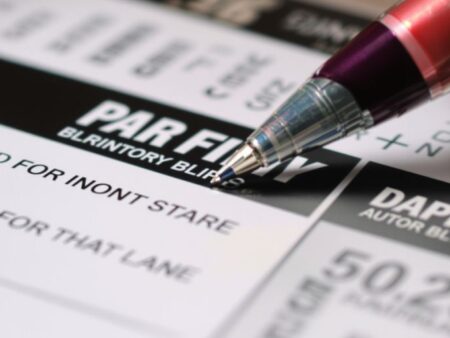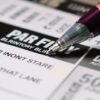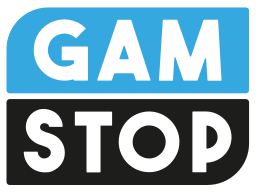Betting on sports can feel like a guessing game sometimes, right? You see the odds, you pick a side, and hope for the best. But what if there was a way to look beyond the surface and really understand what those numbers mean? That’s where implied probability comes in. It’s like a secret code that tells you how likely a sportsbook thinks an outcome is. Learning to crack this code can help you figure out if the odds they’re offering are actually a good deal or if they’re pulling a fast one. This guide is all about how to use implied margin to assess sportsbook value, so you can start making smarter bets.
Key Takeaways
- Implied probability turns betting odds into a percentage, showing what the sportsbook thinks is likely to happen.
- You can calculate implied probability yourself using simple formulas for different odds formats.
- By adding up implied probabilities for all outcomes, you can see the sportsbook’s built-in margin (the ‘vig’).
- Finding value means spotting when your own assessment of an event’s true probability is higher than the sportsbook’s implied probability.
- Understanding how to use implied margin helps you identify overpriced or underpriced odds, leading to more informed betting decisions.
Understanding Implied Probability in Sports Betting
Sometimes, people just want to bet on sports based on who they feel will win. That’s fine, I guess. But if you’re serious about getting some value from your bets, you gotta look at the numbers. One of the best ways to do that is by figuring out implied probability. It’s basically taking the odds a sportsbook gives you and turning them into a percentage. This tells you how likely the sportsbook thinks an outcome is. It sounds complicated, like something from a math class you barely passed, but it’s actually pretty straightforward. Once you get the hang of it, it really helps you see what the odds are actually saying. It’s like getting a secret decoder ring for betting.
Converting Odds to Likelihood
So, how do we turn those funny-looking odds into percentages? It’s not magic, just a little math. For American odds, there are two ways to do it, depending on if the odds are positive or negative. It’s not rocket science, but it does give you a clearer picture of what the bookmaker is thinking.
The Foundation of Value Assessment
Why bother with all this? Because implied probability is the bedrock for finding value. If the sportsbook’s implied probability for an outcome is lower than what you think the real chance is, then you’ve found yourself a potential winner. It’s about spotting when the odds aren’t quite right, and that’s where the money is made. You’re not just guessing anymore; you’re making educated decisions.
Beyond Gut Instinct: A Data-Driven Approach
Forget just picking the team with the coolest logo or the player who scored last week. Implied probability lets you move past that fuzzy feeling and get into the data. It’s about looking at the numbers the sportsbook provides and comparing them to your own research. This approach helps you make smarter bets, plain and simple. It’s a way to bet with your brain, not just your heart.
Calculating Implied Probability: A Practical Guide
Alright, let’s get down to brass tacks. You’ve seen the odds, maybe you’ve got a hunch, but how do you really know what the bookmaker thinks is going to happen? That’s where implied probability comes in. It’s like a secret code that turns those numbers into a percentage, showing you the likelihood of an outcome according to the sportsbook. It’s not magic, it’s just math, and once you get it, things start to make a lot more sense. It helps you see if the odds are actually giving you a fair shake or if they’re a bit off.
Formulas for American Odds
American odds are the most common type you’ll see, especially in the US. They can look a little confusing at first, with plus (+) and minus (-) signs. But don’t sweat it, converting them to implied probability is pretty straightforward.
- For negative odds (like -200): This means you have to bet $200 to win $100. The formula is:
Odds / (Odds + 100). So, for -200 odds, it’s200 / (200 + 100) = 200 / 300 = 0.667. Multiply that by 100 to get 66.7%. - For positive odds (like +150): This means you bet $100 to win $150. The formula is:
100 / (Odds + 100). For +150 odds, it’s100 / (150 + 100) = 100 / 250 = 0.40. Multiply that by 100 to get 40%.
Decoding Positive Odds
When you see odds with a plus sign, like +200, it’s telling you how much profit you’ll make on a $100 bet. So, +200 means you win $200 profit for every $100 you wager. To figure out the implied probability, you take 100 and divide it by the odds plus 100. For example, +200 odds translate to 100 / (200 + 100) = 100 / 300, which equals about 33.3%. This means the sportsbook thinks there’s a 33.3% chance of that outcome happening. It’s a simple way to gauge the bookmaker’s perspective.
Decoding Negative Odds
Now, negative odds, like -150, work a bit differently. They tell you how much you need to bet to win $100 in profit. So, -150 means you have to bet $150 to win $100. To calculate the implied probability here, you take the absolute value of the odds and divide it by the absolute value of the odds plus 100. For -150 odds, that’s 150 / (150 + 100) = 150 / 250, which comes out to 0.60, or 60%. This suggests the sportsbook sees a 60% chance for that particular result. It’s a bit of a different way to look at it, but the math is still pretty clear.
Identifying Sportsbook Margin and Overround
So, you’ve figured out how to turn those cryptic odds into actual probabilities. That’s a big step! But here’s where things get really interesting, and honestly, a little bit like detective work. Sportsbooks aren’t just passive observers; they’re running a business, and like any business, they need to make money. That’s where the concept of ‘margin’ or ‘overround’ comes into play. It’s basically the built-in profit for the bookmaker, and it’s always there, lurking in the odds.
Think about it like this: if you add up the implied probabilities for every single possible outcome of a game, it should, in a perfect world, equal 100%. But that’s not how it works in the real betting world. You’ll almost always see that sum creep above 100%. That extra percentage? That’s the house edge, the ‘vig,’ the ‘juice’ – whatever you want to call it. It’s how they guarantee they profit, no matter who wins. If you bet $100 on both sides of a two-way market and the total implied probability adds up to 104%, you’re guaranteed to lose $4. It’s a small number, sure, but over thousands of bets, it adds up for them. And it means you have to be that much better to overcome it.
The Sum of Probabilities
When you calculate the implied probability for each outcome in a betting market, you’ll notice a pattern. Let’s say you’re looking at a tennis match. Player A is at -200, and Player B is at +160. Converting those odds gives you roughly 66.7% for Player A and 38.5% for Player B. Add them up: 66.7% + 38.5% = 105.2%. That extra 5.2% is the sportsbook’s margin. It’s not a mistake; it’s how they operate. This is a pretty standard overround for a two-way market. You’ll see different numbers for different sports or bet types, but the principle remains the same: the total implied probability will exceed 100%.
Recognizing the House Edge
The house edge, or ‘vig,’ is the percentage the sportsbook keeps from every bet placed. It’s their commission for facilitating the bets and managing the risk. This edge is what allows them to stay in business. For bettors, understanding this edge is key because it directly impacts the value you’re getting. A lower vig means better potential returns for you, assuming you can find favorable odds. It’s why comparing different sportsbooks and their odds is so important; you’re essentially shopping for the lowest commission rate.
Analyzing Multi-Outcome Markets
Things get even more interesting when you look at markets with more than two outcomes, like a football game winner, or a tournament outright winner. Let’s say you’re betting on who wins a soccer league. You’ve got Team A at +300, Team B at +500, Team C at +800, and the ‘Field’ (everyone else) at +1000. Calculating the implied probabilities: Team A (25%), Team B (16.7%), Team C (11.1%), Field (9.1%). Add them up: 25% + 16.7% + 11.1% + 9.1% = 61.9%. Wait, that’s less than 100%! What’s going on here? Ah, this is where you have to be careful. The ‘Field’ bet often includes a massive number of outcomes, and the odds might not be set to reflect a true 100% market. In many cases, especially with futures or long-term bets, the overround can be significantly higher than in single-game markets. It’s not uncommon to see totals well over 110% or even 120% in these scenarios. This means the sportsbook has a much larger built-in advantage, making it harder to find value. You really need to do your homework here.
The Concept of ‘Edge’ in Betting
So, what’s this ‘edge’ thing everyone talks about in betting? It’s basically your advantage, your little secret weapon against the bookmaker. Think of it like this: the sportsbook sets odds based on what they think is most likely to happen. But what if you’ve done your homework, maybe you know a player is playing hurt, or you just have a really good feeling about a certain team? That’s where your edge comes in. It’s the difference between your own calculated probability of an event happening and the probability the sportsbook is implying with their odds. Finding this gap, this discrepancy, is how you start to make money over the long haul. It’s not about luck; it’s about being smarter than the odds.
Defining a Bettor’s Advantage
Your advantage, or ‘edge’, is that sweet spot where your assessment of an event’s likelihood is better than what the sportsbook is offering. It’s when you can look at the odds and say, ‘Hey, I think this is more likely to happen than they do.’ This isn’t just a hunch; it’s usually backed by research, maybe some deep statistical analysis, or even just a really good understanding of a specific sport or league that the bookmakers might have missed. Having an edge means you’ve found a bet where the potential payout is greater than the true probability of winning suggests.
Calculating Your Personal Edge
Calculating your edge is pretty straightforward once you know the implied probability. You take your own estimated probability for an outcome and subtract the sportsbook’s implied probability. So, if you think a team has a 60% chance of winning, but the odds only imply a 50% chance, you’ve got a 10% edge. It’s a simple formula, but it’s powerful.
Edge = (Your Probability – Implied Probability) * 100%
Exploiting Discrepancies in Odds
Once you’ve figured out your edge, the next step is to actually use it. This means actively looking for those bets where your calculated edge is positive. You might categorize games based on the implied probabilities you find. For example:
- Strong Favorites: Implied probability of 66% or higher (like odds of -200 or shorter).
- Moderate Favorites: Implied probability around 60% (odds between -150 and -199).
- Narrow Favorites: Implied probability just over 54% (odds between -120 and -149).
- Close Calls: Implied probability of 54% or less (even money or slight underdogs).
By sorting games this way, you can see where your personal edge might be strongest. If you’re feeling bold, you might chase those bigger payouts in closer matchups where you believe you have a significant edge. If you’re more cautious, you might stick to favorites, but you’ll be looking for those where the implied probability is lower than your own assessment, giving you a small but consistent edge. It’s all about finding value and making smart bets.
Comparing Implied Probability to True Probability
So, you’ve figured out how to turn those cryptic odds into percentages. That’s a big step! But what do those percentages actually mean? They’re what the sportsbook thinks is the chance of something happening, but it’s not the whole story. It’s like looking at a weather forecast – it’s an educated guess, not a crystal ball.
What Are True Odds?
True odds, or what we might call the
How to Use Implied Margin to Assess Sportsbook Value
So, you’ve figured out how to turn those confusing odds into actual percentages. Great! Now what? This is where the real fun begins, or at least, where you stop throwing money away. We’re talking about using what you’ve learned about implied probability to actually spot value, which is basically finding bets where the sportsbook is a bit off. It’s like finding a sale at your favorite store, but for sports bets.
Spotting Overpriced or Underpriced Lines
Think of the sportsbook’s odds as their best guess about how likely something is to happen. When you calculate the implied probability, you’re essentially checking their homework. If a team’s implied probability is, say, 50%, but you’ve done your research and genuinely believe they have a 60% chance of winning, that line is underpriced. You’re getting more bang for your buck. Conversely, if the implied probability is 70% and you think their real chance is only 55%, that line is overpriced. You’re paying too much for the potential payout. It’s all about finding those discrepancies.
Finding Value Opportunities
Value isn’t just about picking winners. It’s about finding situations where the odds offered don’t quite match the actual likelihood of an event. Let’s say you’re looking at a tennis match. The sportsbook has Player A at -200 (implying a 66.7% chance of winning) and Player B at +160 (implying a 38.5% chance of winning). If your analysis suggests Player B has a much better chance, maybe 50%, then that +160 line suddenly looks like a golden opportunity. You’ve found value because the bookmaker’s assessment seems off. It’s these small edges, consistently found, that build a bankroll over time. It’s not about hitting home runs every time, but getting on base.
Making Informed Betting Decisions
Ultimately, this process helps you move beyond just picking the team you like. You’re making calculated decisions based on probabilities. Instead of just betting on the favorite because they’re the favorite, you’re asking: ‘Are the odds fair for this outcome?’ If the implied probability is 75% for a team, but your own assessment is closer to 60%, you’re probably better off passing on that bet. There are thousands of markets out there, and you don’t have to bet on every single one. Focus on the ones where your analysis shows a clear edge. It’s about being disciplined and letting the numbers guide you, not just emotion. It feels good to be right, but it feels better to be profitable.
Leveraging Implied Probability for Betting Strategy
So, you’ve figured out how to turn those confusing odds into actual percentages. That’s a big step, seriously. Now, how do you actually use this stuff to make smarter bets? It’s not just about knowing the numbers; it’s about what you do with them. Think of it like this: you wouldn’t just buy a car without checking its mileage or condition, right? Betting’s the same way. You need to see if the price is right for what you’re getting.
Spotting Overpriced or Underpriced Lines
This is where the magic happens, or at least where you stop losing money unnecessarily. When you calculate the implied probability for a game, you’re essentially seeing what the sportsbook thinks is going to happen. If you do your own research and come up with a different probability – say, you think a team has a 60% chance to win, but the odds only imply a 50% chance – then you’ve found something. That’s a line that might be underpriced, meaning the sportsbook isn’t giving it enough credit. Conversely, if the odds imply a 70% chance but you think it’s only a 50% shot, that line is overpriced. You want to bet on the underpriced ones, obviously.
Finding Value Opportunities
Value isn’t just about picking winners. It’s about picking winners at the right price. Imagine two games: Team A is a -200 favorite, and Team B is a -200 favorite. The implied probability for both is roughly 66.7%. But what if your own analysis shows Team A only has a 55% chance of winning, while Team B actually has a 70% chance? You’d want to bet on Team B, even though they’re the same price. That’s finding value. It’s about aligning the sportsbook’s perceived probability with your own assessment.
Here’s a quick way to think about it:
- Underpriced Lines: Your assessed probability > Implied probability. This is where you find value.
- Fairly Priced Lines: Your assessed probability = Implied probability. No real edge here.
- Overpriced Lines: Your assessed probability < Implied probability. Avoid these.
Making Informed Betting Decisions
Ultimately, this whole process is about making decisions based on data, not just a hunch. It helps you categorize matchups. Are you looking at a heavy favorite where the implied probability is sky-high? Or a close contest where the probabilities are almost even? This helps you manage your bankroll better too. Betting on heavy favorites might seem safe, but the payouts are small. Betting on underdogs can offer big returns, but the implied probabilities are low, meaning you need to be very confident in your assessment to find value there. It’s a balancing act, really. You’re not just betting on the game; you’re betting on the odds themselves.
The Role of Implied Probability in Different Markets
Betting markets aren’t all the same, you know? The odds you see for a big football game are different from, say, a long-shot horse race or a tennis match. Understanding how implied probability works across these different types of bets is pretty important if you want to find real value.
Analyzing Futures and Long-Term Bets
Futures bets, like who will win the championship next season, have odds that are spread out over a much longer time. This means the implied probability for any single team is usually pretty low. Think about it: there are tons of teams, and a lot can happen between now and the end of the season. The sportsbook builds in a bigger margin here because there’s more uncertainty. So, if you see a team at +5000, that’s a tiny implied probability, like 2%. That doesn’t mean they can’t win, but the odds are reflecting a lot of potential variables and the book’s need to cover themselves over that long period. It’s a different beast than a single game.
Evaluating Niche Sports and Competitions
When you get into sports that aren’t as popular, the odds can get a bit wild. Sportsbooks might not have as much data or as many sharp bettors looking at these markets. This can sometimes lead to less efficient pricing. You might find a niche sport where the implied probabilities don’t quite add up right, or where a particular outcome seems way too low or too high compared to what you think is realistic. It’s like finding a hidden gem, but you really gotta know the sport yourself to spot it. If you’re an expert in, I don’t know, competitive eating, and you see odds for that, you might have an edge the book doesn’t.
Understanding Value in Various Betting Types
It’s not just about moneyline bets. Think about point spreads or totals (over/unders). The implied probability calculation is the same, but what you’re looking for changes. For a point spread, you’re not just betting on who wins, but if they’ll cover the spread. The implied probability helps you see if the sportsbook thinks a team is likely to win by exactly that many points, or if they’re just favored to win outright. It’s all about breaking down the odds to see where the market might be mispricing the likelihood of specific outcomes, whether it’s a close game, a blowout, or a high-scoring affair. Finding value means the odds suggest a lower probability than you believe is accurate.
Limitations and Considerations of Implied Probability
Implied Probability Is Not a Guarantee
Look, nobody has a crystal ball, right? Implied probability is just what the bookmaker thinks will happen, based on the numbers they put out there. It’s not some magic spell that locks in a win. Sports are wild, and upsets happen all the time. Just because the odds say one team has a 90% chance of winning doesn’t mean they actually will. Remember that crazy game last week? Nobody saw that coming. Betting based on these probabilities is smart, but it’s not a sure thing. You still gotta remember that what happens on the field, court, or ice is what matters most.
The Unpredictability of Sports Outcomes
This is the big one, folks. Sports are inherently unpredictable. That’s why we love ’em, right? A bounce of the puck, a bad call, a player having an off night – any little thing can flip a game on its head. Even when the math looks solid, and the implied probability points to a clear favorite, there’s always that chance for a shocker. It’s like when I tried to bake that fancy cake for Sarah’s birthday. Followed the recipe to a T, but somehow it came out looking like a deflated football. Turns out, oven temperatures can be a bit… temperamental. Sports are kind of like that, but with more cheering and less flour.
The Importance of Continuous Research
So, you can’t just set it and forget it. Relying solely on implied probability without doing your own homework is a recipe for disaster. You need to dig deeper. What’s the team’s recent form? Are there key injuries? How do they perform against this specific opponent? This kind of research helps you build your own sense of the ‘true’ probability, which you can then compare to what the sportsbook is offering. It’s a constant process, always learning and adapting. Think of it like trying to find the best pizza place in town. You can’t just go to the first one you see; you gotta try a few, read reviews, maybe ask some locals. It takes effort, but finding that perfect slice? Totally worth it.
Sharpening Your Betting Acumen with Probability
So, you’ve figured out how to turn those confusing odds into actual probabilities. That’s a big step, seriously. But what do you do with that information? It’s not just about knowing the numbers; it’s about using them to get smarter with your bets. Think of it like this: you wouldn’t go into a chess match without knowing the basic moves, right? This is the same idea, but for sports betting. It’s about moving past just guessing and actually having a plan.
Moving from Casual to Calculated Betting
Look, anyone can throw a few bucks on a game because they like a team’s colors or a player’s name. That’s fine if you’re just playing for fun, but if you want to actually win more often, you need to be more deliberate. Calculating implied probability helps you do just that. It forces you to look at the odds and think, ‘Okay, what does the sportsbook really think is going to happen here?’ Then, you compare that to what you think is going to happen. This comparison is where the magic starts to happen, or at least, where the potential for winning starts to show up.
Improving Long-Term Betting Results
Nobody wins every bet. That’s just a fact of life, and sports betting is no different. But what separates the folks who are consistently losing from those who are actually making money over time? It’s usually their approach. By using implied probability, you start to see patterns. You might notice that you’re consistently better at predicting outcomes in certain sports or leagues. Or maybe you find that the sportsbooks are often overvaluing certain types of bets. Identifying these small edges, consistently, is what leads to better results down the road. It’s not about hitting a home run every time; it’s about getting on base more often.
The Advantage of Probabilistic Thinking
Let’s break down how you might categorize games using implied probability. This isn’t just busywork; it helps you make better decisions about where to put your money.
- Strong Favorites: These are games where the implied probability is 66% or higher. Think odds like -200 or shorter. Betting here is usually safer, but the payouts are smaller. It’s like picking up pennies in front of a steamroller – steady, but not exciting.
- Moderate Favorites: Here, the implied probability is around 60%, maybe odds like -150 to -199. Still a favorite, but a bit less certain.
- Narrow Favorites/Close Calls: This is where things get interesting. Implied probability might be just over 54% down to even money. These are the toss-ups, the games that are hard to call. This is often where the best value lies if you can figure out who actually has the edge.
By sorting games like this, you can start to match them with your own comfort level for risk. Are you the type who likes to play it safe with the big favorites, or do you prefer to hunt for those bigger payouts in the closer matchups? Your personal assessment of the true probability, compared to what the odds suggest, is what really matters here. It’s your edge, and that’s what we’re trying to find.
Putting It All Together
So, after breaking down how implied probability works, we can see it’s not just about looking at the numbers the sportsbook gives us. It’s about turning those numbers into a real chance, a percentage, so we can figure out if the odds make sense. When our own research suggests a team has a better shot than the odds imply, that’s where we find value. It’s not about predicting the future perfectly, but about spotting when the sportsbook might be off. By consistently doing this, we can start making smarter bets and hopefully see better results over time. It’s a solid way to move beyond just guessing and start betting with a bit more confidence.
Frequently Asked Questions
What exactly is implied probability in sports betting?
Implied probability is like a secret code in betting odds. It turns the numbers (like -150 or +200) into a percentage that shows how likely the betting site thinks an event will happen. It’s a way to see what the odds are really saying about a team’s chances.
How do I figure out the percentage chance from the odds?
Think of it like this: If a betting site gives odds of -200 for a team to win, that means they think that team has about a 66.7% chance of winning. If the odds are +150, they think that team has about a 40% chance. It’s just converting the odds into a likelihood percentage.
What is the ‘house edge’ and how does it show up in implied probability?
The betting site’s odds include a little extra charge, like a fee, to make sure they make money no matter what. This is called the ‘house edge’ or ‘overround.’ When you add up the implied probabilities for all possible outcomes, it usually adds up to more than 100%. That extra bit is the bookie’s profit margin.
What does it mean to have an ‘edge’ in betting?
Your ‘edge’ is your own advantage. It’s when you figure out that a team has a better chance of winning than the betting site’s odds suggest. For example, if you think a team has a 60% chance to win, but the odds only imply a 50% chance, you’ve found an edge. It means you might have a better understanding of the game than the bookie.
What’s the difference between implied probability and ‘true’ probability?
True odds are what you believe the actual chances of an event happening are, after doing your own research. Implied probability is what the betting site *thinks* the chances are, based on their odds. If your ‘true odds’ are different from the implied probability, you might have found a good bet.
How can implied probability help me find good bets?
You can use implied probability to see if a bet is a good deal. If the odds suggest a team has a low chance of winning, but you think they have a good chance, the odds might be ‘underpriced,’ meaning it’s a good value bet. It helps you find bets where the betting site might be wrong.
How does implied probability help with my betting strategy?
Knowing implied probability helps you make smarter choices. You can sort games by how likely each team is to win. This helps you decide if you want to bet on a strong favorite (less risk, smaller payout) or an underdog (more risk, bigger payout) based on your own research and how much risk you’re okay with.
Does implied probability mean I’ll always win my bets?
Implied probability is a great tool, but it’s not a guarantee. Betting sites can be wrong, and upsets happen all the time! It’s based on numbers and estimates, not a crystal ball. You still need to do your own research and understand that sports can be unpredictable.























